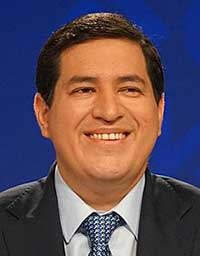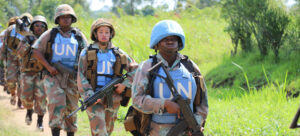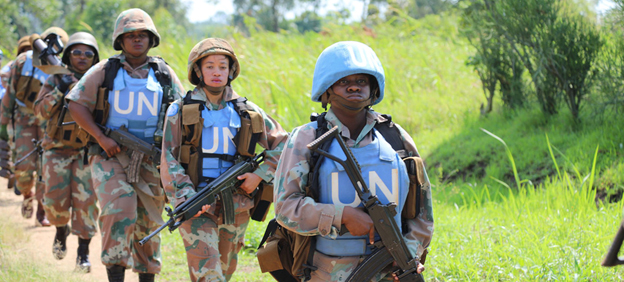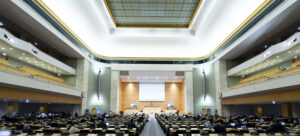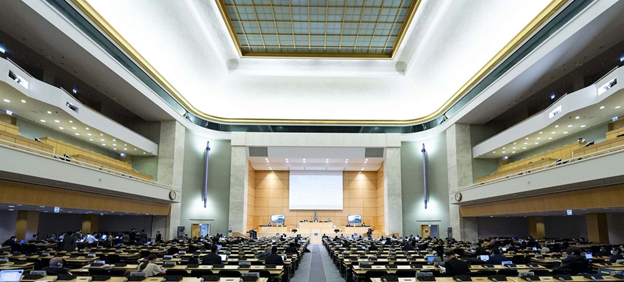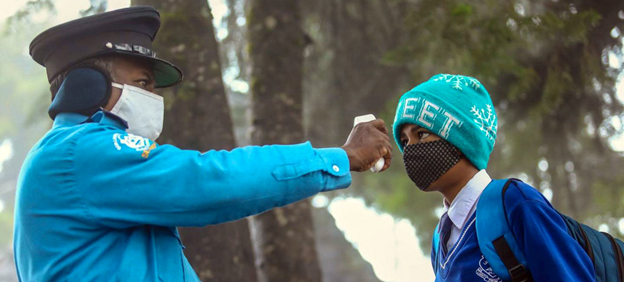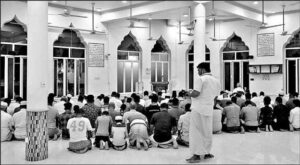
Armed Conflicts, Asia-Pacific, Civil Society, Crime & Justice, Featured, Headlines, Human Rights, Humanitarian Emergencies, Religion, TerraViva United Nations
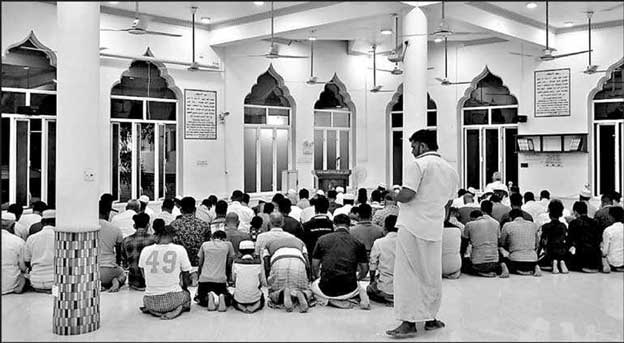
Muslims at a mosque in Sri Lanka. Credit: Financial Times, Sri Lanka
– On 28 October, President Gotabaya Rajapaksa appointed the militant Buddhist monk Galagoda Aththe Gnanasara to head a presidential task force on legal reforms, shocking many in Sri Lanka and beyond. Gnanasara is the public face of the country’s leading anti-Muslim campaign group, Bodu Bala Sena (Army of Buddhist Power, or BBS). He is widely accused of inciting inter-communal violence, including two deadly anti-Muslim pogroms in June 2014 and March 2018.
Convicted of contempt of court for a separate incident, Gnanasara was sentenced to six years in prison but received a presidential pardon from Rajapaksa’s predecessor, Maithripala Sirisena, in his final months in office. The act of clemency came after intensive lobbying by nationalist monks and an upsurge of anti-Muslim sentiment in the aftermath of the 2019 Easter bombings, a series of attacks on churches and tourist hotels carried out by a small group claiming allegiance to the Islamic State, or ISIS.
Observers across the Sri Lankan political spectrum, including some Buddhist nationalists, expressed dismay – at times, outrage – that the president could name someone whose disrespect for the law and hostility to non-Sinhala Buddhist minorities are a matter of public record to head a commission ostensibly designed to prevent “discrimination” and ensure “humanitarian values”. Critics have called the appointment “irrational” and even “incomprehensible”.
In fact, it is anything but. The Rajapaksa government is deeply unpopular, including among large sections of its core Sinhala Buddhist constituency, and desperate to divert public attention from its economic mismanagement.
There is thus a clear if deeply unfortunate logic for it to bring back to the fore the best-known proponent of a theme that was key to getting the president elected: fear of Muslims as a source of “religious extremism”.
While it was in one sense surprising to see the open affirmation of Rajapaksa’s active support for the controversial monk after many years of distancing himself from Gnanasara, tight links between Sri Lankan government officials and the Buddhist clergy are nothing new. The 1978 constitution gives Buddhism the “foremost place” in the country’s religious landscape and the state the duty to “protect” it.
There is nothing comforting in this history, however. The Sinhala Buddhist majoritarian nature of the Sri Lankan state – ie, the extent to which the state represents and enforces majority interests at the expense of the rights of other communities – has had disastrous effects on the country’s ethnic and religious minorities.
The state’s transition from being structurally discriminatory to openly hostile toward Tamils (who are Hindu or Christian) – a process fed by Sinhala politicians’ warnings about the threat the community allegedly posed – ultimately led to three decades of devastating civil war.
During that period, from 1983 to 2009, terrorist attacks by the Liberation Tigers of Tamil Eelam provided some objective grounds for Sinhalese fears, reinforcing the narrative that the majority community was under threat. Now, there is growing reason to fear that this pattern may be repeating itself in the Sri Lankan state’s interactions with its Muslim citizens.
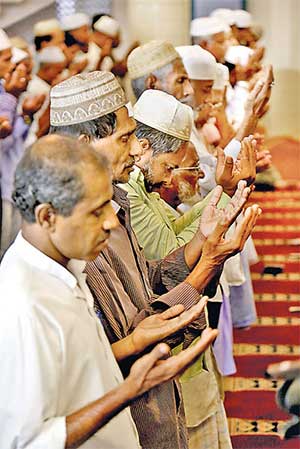
Credit: Sunday Times, Sri Lanka
The Rise of Anti-Muslim Politics
In November 2019, Gotabaya Rajapaksa’s successful campaign for Sri Lanka’s presidency made much of the slogan “one country, one law”, which had gained popularity after the 2019 Easter bombings. Its ambiguity was useful: at one level, it could be interpreted as merely asking for uniform treatment of all citizens and resonated with voters angry at the impunity with which politicians and their powerful supporters are able to violate the law.
But its discriminatory implication was also obvious from the start, hinting at a need to “protect” the Buddhist nature of state and society by eliminating the separate rules and treatment that many Sinhalese believe Muslims use to gain economic and political advantages.
Many Sinhalese have for years held the view that Sri Lankan Muslims are more concerned with advancing their own interests than working for the larger national interest. Even during the civil war, when Muslims remained overwhelmingly loyal to the state and played a critical role in fighting the Tamil insurgency, one regularly heard complaints in Sinhalese (as well as Tamil) circles that they were exploiting the conflict for personal and collective economic benefit.
Because Muslim lawmakers held the balance of power in parliament between the two major Sinhala-dominated parties, they were commonly accused of using their “kingmaker” role to gain undue advantages for their co-religionists.
By the early 2000s, many Sinhalese had also begun to express discomfort at the increasing numbers of Muslims, especially women, wearing religious attire and the growing focus among Muslims on practices meant to demonstrate religious piety. Many interpreted this trend as Muslims deliberately distancing themselves from the majority.
With the arrival of BBS ultra-nationalists on the political scene in late 2012 – whose message was amplified by the smaller militant Sinhalese groups Sinhala Ravaya and Ravana Balakaya – the public portrayal of Sri Lankan Muslims rapidly took on more overtly hostile forms. (The decade earlier had seen organised Buddhist activism, at times violent, directed against the growing number of evangelical churches; pressure on Christian evangelicals continues today, though not on the scale of anti-Muslim campaigns.)
At the height of its influence, in 2013 and 2014, BBS dominated news coverage and helped set the political agenda through rallies, speeches and vigilante actions aimed at containing the threat Muslims’ alleged “extremism” posed to Sri Lanka’s Sinhala Buddhist character. The range of allegations promoted by BBS and like-minded organisations, often through online hate speech, was broad and shifting.
They claimed that population growth meant that Muslims would eventually overtake the Sinhalese majority; that Muslim-owned businesses were secretly distributing products to sterilise Sinhalese in order to keep their numbers down; and that the system of halal food labelling was encroaching on the religious rights of others and covertly funding Islamist militants.
More generally, conservative religious practices adopted by increasing numbers of Muslims in a quest for greater piety were read by ultra-nationalists as evidence of growing “extremism” that threatened other communities. These charges were based on either outright falsehoods or malicious misinterpretations of complex social and religious developments among Sri Lankan Muslims.
The anti-Muslim rhetoric helped set off inter-communal violence late in the presidency of Gotabaya’s brother Mahinda Rajapaksa (2005-2015). These years saw a series of attacks on Muslim-owned businesses (with many alleging that Sinhala business rivals were backing the attackers) and disruption of political meetings held by anyone daring to challenge the Buddhist militants, against the backdrop of mass rallies denouncing the alleged threat posed by Muslims’ “extremism”.
In a June 2014 speech in the town of Aluthgama, Gnanasara declared to a large crowd: “This country still has a Sinhala police. A Sinhala army. If a single Sinhalese is touched, that will be the end of them all [Muslims]”. Minutes later, hundreds of his supporters marched through a nearby Muslim neighbourhood, sparking two days of devastation that left three Muslims and one Tamil security guard dead. Sinhala rioters, many of them brought in from outside the area, targeted mosques and Muslim-owned shops and homes for arson and destruction. The police were widely accused of standing by or even assisting the rioters.
Despite government denials, many independent observers told Crisis Group at the time that the Mahinda Rajapaksa administration was actively supporting the BBS and other anti-Muslim campaigns. They suspected the government of executing an electoral strategy designed to consolidate the Sinhala vote behind the government, which projected itself as the defender of Sinhalese Buddhist identity. The appearance of Gotabaya Rajapaksa, then defence secretary, at a BBS event in March 2013, and his known connections with senior monks associated with the group, fuelled the speculation.
More tangible evidence of state backing lay in the fact that police gave BBS and like-minded groups permission to hold rallies at a time when government critics were not allowed to do so. Police took no apparent action, moreover, to prevent or investigate repeated vigilante raids on Muslim-owned shops or violent efforts to silence critics of militant Buddhist organisations.
Nor was anyone prosecuted for any of these crimes. Multiple sources told Crisis Group that Senior Deputy Inspector General of Police Anura Senanayake, who worked closely with Gotabaya at the time, led efforts to persuade victims not to press charges. Following Mahinda’s defeat in the January 2015 election, officials announced they had evidence of close ties between Buddhist militants and military intelligence units, confirming what Muslim community leaders had previously told Crisis Group.
With the 2015 election of President Maithripala Sirisena, representing a united opposition determined to end the Rajapaksas’ rule, the strategy of demonising Muslims for electoral ends seemed to have failed. Sirisena’s yahapaalanaya (good governance) coalition won in part through strong Muslim and Tamil backing based on its promises to end the BBS-led reign of terror.
But while the new administration stopped tacitly encouraging anti-Muslim violence and hate speech, it lacked the political courage – and possibly the necessary support within the police and intelligence agencies – to crack down on Buddhist militant groups.
After a brief lull in anti-Muslim activism, 2016 and 2017 saw a series of small attacks on Muslim businesses by unknown assailants, encouraged by sustained hate speech campaigns in traditional and social media, backed by effective local networks.
In February 2018, Buddhist militants in Ampara damaged a mosque and Muslim-owned shops as the police looked on, following social media rumours that a Muslim-owned restaurant had injected sterilising chemicals into Sinhala customers’ food. The following month, four days of anti-Muslim rioting shook the central hill district of Kandy, sparked by the death of a Sinhala man assaulted weeks earlier by four Muslim men.
Gnanasara visited the victim’s family and later joined other militant leaders to address a crowd of protesters just hours before the riots began. Videos later appeared to show local politicians from the Rajapaksa family’s party, the Sri Lanka Podujana Peramuna, taking part in the mayhem. Two people were killed, many injured, hundreds of Muslim-owned houses and shops destroyed, and at least a dozen mosques damaged. The violence was severe enough for President Sirisena to declare a state of emergency, during which the army eventually brought things under control.
President Sirisena, Prime Minister Ranil Wickremesinghe and senior ministers all condemned the violence and promised tough action in response. But despite hundreds of arrests, including of several prominent Buddhist activists, no one was held accountable for these incidents, which included well-documented attacks on Muslims by security forces, with eyewitnesses telling Crisis Group of numerous cases of complicity between the police and Buddhist rioters.
In August 2018, courts eventually convicted Gnanasara of contempt of court and criminal intimidation of a prominent Sinhala human rights activist. Many hailed his six-year sentence as a landmark, though Gnanasara has faced no jail time for attacks on or other actions against Muslims, and most of the slow-moving criminal cases against him in lower courts have now been dropped.
The partial victory over impunity was, however, short-lived. In 2019, in the aftermath of the horrific Easter Sunday suicide attacks, the Sri Lankan state for the first time adopted policies that directly discriminated against the Muslim minority. With tensions running high, President Sirisena’s government used the post-bombing state of emergency to prohibit the niqab, or full face covering, invoking national security concerns (the ban was rescinded in August 2019 when the emergency was lifted).
It also enacted new rules for government employees that, in effect, barred the full-length abaya, worn by many Muslim women teachers, especially in the Eastern Province (these were later withdrawn after being challenged by Sri Lanka’s Human Rights Commission). Anxious to salvage his sinking political fortunes as the November 2019 presidential election drew near, Sirisena then pardoned Gnanasara.
The nationalist monk immediately leapt into the political fray, joining his peers in protests demanding the resignation of Muslim ministers Rishad Bathiudeen and Azath Salley, accusing them – to date without convincing evidence – of involvement in the Easter attacks.
For many Sinhalese, especially Christians, as well as some Tamils, the Easter attacks seemed to confirm earlier warnings of a growing threat from “Islamic extremism”. Authorities responded to these fears in the attacks’ aftermath with what appeared to be the criminalisation of Muslims’ everyday practices.
Police arrested more than two thousand Muslims under emergency and terrorism laws, in all but a few cases with no evidence of links to the bombings or any threatening behaviour; they picked up many merely for having a Quran or other religious materials in Arabic script at home.
After the Easter bombings, the previously failed electoral strategy of shoring up Sinhala support through vilification of Muslims gained new traction. Gotabaya announced his candidacy just days after the attacks, promising to eradicate new forms of religiously motivated terrorism just as he had previously destroyed the Tamil Tigers when he was defence secretary.
At the polls, Gotabaya received overwhelming support from Sinhala voters, including many Catholics who had not previously backed him. The new president himself seemed to acknowledge the strategy’s success, declaring in his inaugural speech given in front of a Buddhist shrine: “I knew that I could win with only the votes of the Sinhala majority”.
Growing Tensions
Within months of taking office, Gotabaya deepened the state’s hostility toward Muslims on several fronts. His administration used COVID-19 lockdowns and ad hoc village-level quarantines to harass the community, which pro-government media outlets accused of spreading the virus. More damaging was the government’s decision on 1 April 2020 to ban burial of anyone even suspected of having died of the disease.
Announced the day after the first Muslim victim died, the decision was justified by a claim – quickly rejected by the World Health Organisation and Sri Lankan experts – that the virus could spread from interred remains through the groundwater. The policy, which stayed in place for nearly a year, had a profoundly cruel effect on Muslim families, who were forced to cremate their loved ones’ bodies against their religious convictions.
It was rescinded on 26 February, after a global advocacy campaign that sought to mobilise the Organisation of Islamic Cooperation and member states of the UN Human Rights Council, which was due to assess Sri Lanka’s human rights record weeks later. Even after the ban was lifted, however, Sri Lanka has allowed burials in only one remote location, heavily guarded by the military – a limitation that continues to impose hardships on Muslims, as well as the smaller number of Christians and Hindus who choose to bury their dead.
On 12 March, the government also announced new regulations for “deradicalisation” of those “holding violent extremist religious ideology”. Issued under the draconian Prevention of Terrorism Act, the rules allowed the defence ministry to detain anyone accused of causing “acts of violence or religious, racial or communal disharmony or feelings of ill will or hostility between different communities or racial or religious groups” for up to eighteen months, without any judicial process or oversight.
Human rights lawyers and Muslim leaders quickly filed suit in the Supreme Court, which in August put the measures on hold until it decides the case. Even if the court quashes the regulations, however, the government’s clear intention to establish a “deradicalisation” program leads some to believe it may enshrine similar powers in revisions to the counter-terrorism law it is presently preparing.
The regulations were issued without evidence that any significant number of Muslims in Sri Lanka posed a threat to security or would benefit from a program along the contemplated lines. They did, however, offer the government a face-saving way to release some of the hundreds of Muslims arrested after the Easter attacks who are still detained, in some cases without charge, by putting them into a “deradicalisation program”.
Holding large numbers of Muslims in special camps for another year or more, as the proposed deradicalisation program would do, however, would risk contributing to a collective sense of humiliation and anger that could itself push some toward “violent extremist religious ideology”. As Muslim activists regularly warn, the risk is particularly high as long as the government’s approach leaves no room for the possibility that Buddhists could promote their own forms of violent extremism.
Overlapping enquiries into the Easter bombings have, meanwhile, been politicised in ways that appear aimed at keeping alive fears of Muslims as a source of insecurity. As part of its broader attack on the independence of police and courts, Gotabaya’s government replaced the entire team looking into the bombings soon after coming to power, arrested the chief investigator, Shani Abeysekera, on what appear to be trumped-up charges, and demoted other officers. Another key investigator fled the country fearing arrest.
The administration has also refused to act on the key recommendations of a separate commission of enquiry – appointed by President Sirisena – into the bombings. These included, among others, prosecuting Sirisena, who is now a key government ally, and banning BBS, whose anti-Muslim incitement the commission found had contributed to the bombers’ turn to violence in a process of “reciprocal radicalisation”.
In what seems to be an attempt at maligning Muslim leaders, the Gotabaya administration also detained or charged a number of prominent Muslim personalities, seemingly without credible grounds. Ex-minister Bathiudeen faces terrorism and extremism charges – despite having been cleared of links to the Easter bombings by the presidential commission of enquiry.
On 2 December, a court released another Muslim lawmaker, Salley, after he had spent eight months in jail, citing lack of evidence. The prosecution of human rights lawyer and political activist Hejaaz Hizbullah for his supposed links to the Easter terrorist attacks also appears to be groundless, relying in part on coerced testimonies.
The government’s approach has angered Sri Lanka’s Catholic leadership, which has accused it, and the president himself, of covering up the “masterminds” behind the Easter bombings. Church leaders suggest that the government has been protecting Sirisena and refusing to follow up on evidence uncovered by the presidential commission that implies military intelligence officers had contact with some of the bombers before and on the day of the attack.
Backed by Pope Francis, Colombo’s archbishop Cardinal Malcolm Ranjith has called for an international investigation. Following an October online meeting that aired church criticisms, the police summoned one of the cardinal’s top advisers for three days of questioning.
A Dangerous Slogan
Stung by growing criticism of its handling of the Easter bombings investigation, and facing a grave economic crisis that has badly damaged its popular support, including among Sinhala Buddhists, the Rajapaksa government signalled with Gnanasara’s appointment that it is returning to the “one country, one law” agenda that helped get it elected.
Given the concept’s vagueness, however, and the deep contradiction between it and the explicit privileges that Buddhism enjoys under the constitution, no one is sure what Gnanasara’s task force will actually do. While it can, in principle, look into the practices of all religious and ethnic groups, few observers doubt that it will focus its attention on the Muslim minority.
It is expected to consider reforms to the madrasa education system – Muslim leaders have submitted proposals to the government – as well as government plans to regulate activities in mosques, monitor the import and translation of the Quran and other Arabic texts, ban the niqab and burqa, and outlaw cattle slaughter (an industry dominated by Muslims and often criticised by Buddhist activists).
Gnanasara’s task force also seems certain to weigh in on long-discussed changes to the Muslim Marriage and Divorce Act, a new version of which the cabinet approved in August. Over the past years, Muslims and others have bitterly debated possible reforms to the Act, with complicated overlap between human rights and feminist critiques of the legislation as patriarchal and oppressive and Buddhist nationalist criticisms of Muslims having their own marriage and family law.
Sri Lankan law enshrines distinct traditions of family law for Sinhalese in Kandy and Tamils in Jaffna, as well as for Muslims, but this Act has come in for particular criticism on account of allowing polygamy, setting no minimum age for marriage, requiring no explicit consent from the bride and establishing all-male courts to hear divorce cases.
But Gnanasara’s involvement in government efforts to alter it will likely weaken the leverage of Muslim feminist reformers pushing to strengthen women’s marriage and divorce rights and strengthen resistance to change from the all-male communal leadership, which has argued that feminist criticisms of the law, in effect, endorse Buddhist militant portrayals of Islam as a backward religion.
It remains to be seen, however, how far the government will allow or encourage Gnanasara to go. On the one hand, Buddhist nationalists appear to see “one country, one law” as a call for “a single law” that gives pre-eminence to Buddhist institutions while denying those of other religions official recognition.
Some top officials clearly see things the same way: it was particularly revealing that Gnanasara’s appointment was followed three weeks later by a series of large-scale Buddhist religious ceremonies in the sacred city of Anuradhapura, featuring the president, cabinet and top military brass alongside the Mahanayakes, Sri Lanka’s most powerful Buddhist clerics.
The two days of ceremonies were grand displays of the government’s project of more fully integrating state, military and Buddhist clergy on the basis of an overtly Sinhala nationalist political vision. On the other hand, in a December meeting, Foreign Minister G.L. Peiris assured ambassadors from Muslim countries that Sri Lanka would “continue to retain” “personal laws specific to Muslim, Kandyan and Tamil communities”.
Moreover, to date, Colombo has carefully calibrated its anti-Muslim policies so as to keep the backing of its hardline Buddhist nationalist supporters and win a degree of international support for helping “counter violent extremism”, while maintaining good relations with economic and political allies in the Muslim world.
The government may as yet have no precise agenda for the task force, but given Gnanasara’s charisma and theatrical skills, he is a potentially powerful, and dangerous, asset for reframing political debate, deepening divisions between Tamils and Muslims and possibly even provoking a new round of anti-Muslim unrest. He has been central in propagating Buddhist nationalist ideology over the last decade.
There is little that those outside of Sri Lanka, concerned about the rule of law, religious harmony and political stability, can do directly to address these dynamics. Foreign partners of the Sri Lankan state, can, however, be more careful about not inadvertently strengthening them.
Following the Easter bombings, a range of new programming by foreign donors has focused on counter-terrorism, preventing “violent extremism” and building “social cohesion”. In the words of one activist, though, “There is a lot of foreign funding to the government for ‘countering violent extremism’ but it only targets one faith. … No one dares tell the government to ‘rehabilitate’ Gnanasara or other extremist monks”.
Until such programming finds – or creates – the space to name and challenge the violent history, rhetoric and exclusionary political projects of all communities, it is more likely to perpetuate, rather than resist, the anti-Muslim ideology that today poses the greatest risk of destabilising violence in a country that has yet to recover from decades of brutal civil war.
The link to the original article: “One Country, One Law”: The Sri Lankan State’s Hostility toward Muslims Grows Deeper.
Alan Keenan is Senior Consultant, Sri Lanka, at the International Crisis Group in Brussels.
Source: International Crisis Group

